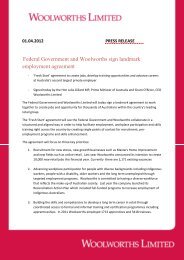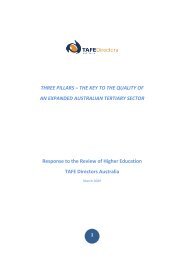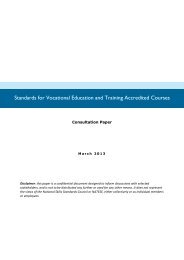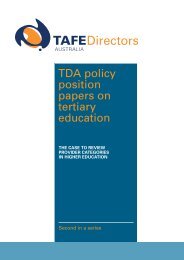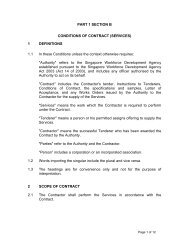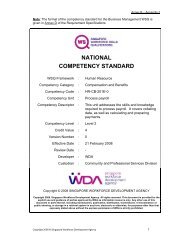Occasional Paper - TAFE Directors Australia
Occasional Paper - TAFE Directors Australia
Occasional Paper - TAFE Directors Australia
You also want an ePaper? Increase the reach of your titles
YUMPU automatically turns print PDFs into web optimized ePapers that Google loves.
32<br />
<strong>TAFE</strong> IN THE YEAR OF THE TIGER<br />
Statistical approaches<br />
There are two basic approaches to adjust for the fact<br />
that providers have different student profiles, and<br />
these differences impact on performance indicators.<br />
First, multilevel regression can be used to separate<br />
the provider specific aspect of an indicator from<br />
the effect of the characteristics of students. An<br />
example is given in Curtis (forthcoming 2010) in<br />
which the module completion rate of individual<br />
<strong>TAFE</strong>s is modelled as a function of a range of student<br />
characteristics. The control variables comprise:<br />
gender, age, indigenous status, disability status,<br />
commencement status, location, employment<br />
status, school attainment, post-school qualifications,<br />
reasons for study, study load, whether at school,<br />
main field of education, <strong>Australia</strong>n Qualifications<br />
Framework (AQF) level, main delivery mode and<br />
main funding source. Curtis finds that 95% of<br />
the variation in observed module pass rates can<br />
be explained by these characteristics of students,<br />
leaving 5% of the variation which is attributed<br />
to institutional factors. Putting it another way,<br />
the observed modules pass rates are a very poor<br />
indicator of institutional performance and it<br />
would be inappropriate to use the raw scores as<br />
an indicator of performance. When institutions are<br />
ranked by the modelled module pass-rate (that<br />
is, abstracting from student characteristics), we<br />
find that there are bands at the top and bottom<br />
in which the providers are statistically different,<br />
but the performance of many in the middle is not<br />
statistically different from each other. Figure 1 shows<br />
the results with the diamond representing the<br />
modelled performance relative to the overall average<br />
(the bars show statistical confidence intervals).<br />
Figure 1 Profile-adjusted competency<br />
completion rates for <strong>TAFE</strong> providers<br />
This graphical presentation shows why relative<br />
performance should not be converted into ranks, for<br />
the simple reason that the middle performers are<br />
very close to each other. For example, <strong>TAFE</strong>s ranked<br />
between 10 and 20 are not statistically different<br />
from each other.<br />
The second approach is to identify peers for each<br />
provider.<br />
There are various ways of doing this. The first is to<br />
take a naive approach and group them together on<br />
variables that have some face validity. For example,<br />
we could classify providers by size and whether they<br />
are city based or not. The obvious difficulty with this<br />
is that two providers may be similar in size but have<br />
very different orientations and student bases.<br />
The second way is to undertake a multivariate<br />
cluster analysis which groups providers together<br />
on the basis of certain characteristics. Essentially<br />
the technique works out the distance between<br />
providers on the basis of differences between<br />
the characteristics. The advantage of this method<br />
over the first method is that it is less arbitrary and<br />
can take into account a considerable number of





